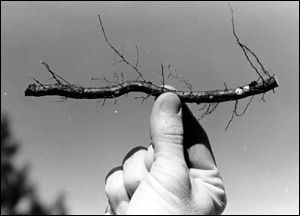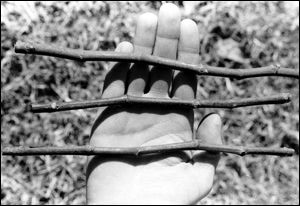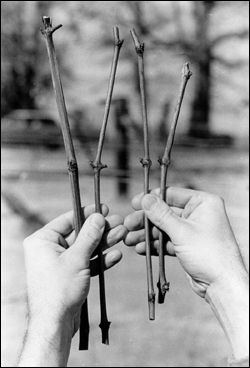Excerpts from
"Propagating Deciduous Fruit Plants Common to Georgia"
by M. E. Ferree and Gerard Krewer, University of Georgia, Cooperative
Extension
Cuttings
Types
Three
types of cuttings are used to propagate specific fruit plants common to
Georgia. Root cutting is the simplest method of propagation, and only
erect blackberries are satisfactorily reproduced by this method.
Hardwood cuttings, stem cuttings taken in the dormant season, are also
an easy method of reproducing fruit plants. Figs and bunch grapes are
most often propagated by hardwood cuttings. The softwood cutting method
of fruit plant propagation is most commonly used to propagate rabbiteye
blueberries and muscadine grapes, and is occasionally used to propagate
figs. A mist system to keep the foliage of the cuttings from drying out
is necessary, making this method of propagation more complicated than
the root or the hardwood cutting methods.
Root Cuttings
Erect
blackberries are most often propagated by root cuttings planted
directly in the field where the berries are to be permanently situated.
Root cuttings should be the diameter of a pencil and 4 to 6 inches long
(Fig. 1). These cuttings are placed horizontally about 2 inches deep
in the soil in March. Shoots should appear in four to eight weeks. If
storage of the roots is necessary before planting, moisten them and
store in a plastic bag at 34° to 38°F until time to
plant.

Fig. 1 Root cutting
Hardwood
Cuttings
Figs
are generally propagated by 8- to 10-inch long hardwood cuttings of the
previous year’s growth (Fig. 2) and placed in a nursery row
about 4 inches apart in late February or March. Place the cuttings at a
depth so only the top bud is exposed. The base cut on the fig cutting
should be ½ inch below a node; the top cut on each cutting
should be ½ inch above a node. Rooted plants are dug the
following winter.

Fig. 2 Fig cuttings
Bunch and
French hybrid grapes
are propagated by hardwood cuttings taken any time during the dormant
season. For varieties such as Fredonia, select canes with buds 3 to 5
inches apart and make cuttings at least three buds long (Fig. 3). For
less vigorous varieties, such as Delaware, select canes with shorter
internodes and leave more buds per cutting.

Fig. 3 Grape cuttings
Place
these cuttings in a rooting box so only the top bud is exposed. The
rooting medium should be sand, sand and peat, or sand and vermiculite,
and should be kept moist at all times. Roots should appear in three to
six weeks.
After rooting begins, the cuttings can be planted in the nursery row or
in their permanent location in the vineyard.
Softwood
Cuttings
Rabbiteye
blueberry
plants are grown from softwood cuttings. Cuttings should be taken
immediately after the first flush of growth in the spring. Using wood
that is about 1/8 inch in diameter, make cuttings 4 inches long. Leave
three or four upper leaves and place approximately 2½ inches
deep in the rooting bed. The rooting medium should consist of half peat
and half clean sand by volume. A rooting hormone is not needed. These
cuttings should be placed under intermittent mist.
When cuttings
have rooted well (generally five to seven weeks), gradually reduce
misting and allow the plants to harden. Water only when the surface of
the medium becomes dry. Plants may be left in the bed covered with
glass or polyethylene for protection during the winter. Grow rooted
plants at least one year in a nursery row before moving them to their
permanent location.
Muscadine
grapes
are propagated by two methods: softwood cuttings or layering.
Propagation of large quantities of plants is easier and quicker using
softwood cuttings taken in late June. Use the current
season’s
shoots. Cut off and discard the tender tip and make cuttings from the
rest of the shoot. Leave four nodes on each 4- to 6-inch cutting. Keep
the cuttings moist to avoid wilting. Remove the two basal leaves on
each cutting, treat the base of the cutting with a rooting hormone
(optional), and line them out on a 3-by-4 inch spacing. The medium in
the propagation bed should be a mixture of one part coarse sand and one
part peat. Provide shade by blocking out about 50 percent of the direct
sunlight with shade cloth or lath.
Maintain the humidity near
100 percent by intermittent mist. When the cuttings root and the shoots
begin to grow, remove the shade. Gradually reduce misting and fertilize
with a solution of one tablespoon of 20-20-20 soluble fertilizer per
gallon of water once a week until mid-September. Use one gallon per 25
square feet of plant bed. Allow the plants to harden. Water only when
needed. When dormant, these plants can be dug and planted in the
vineyard, or planted in the nursery to grow for a year.
Figs,
although generally propagated by hardwood cuttings, are sometimes
propagated by softwood cuttings. Softwood cuttings of actively growing
fig shoots can be propagated under intermittent mist. Treatment of the
base of the cutting with a rooting hormone is not necessary. However,
two nodes should be placed in the medium. The base cut should be
½ inch below a node. Rooting should begin in three to four
weeks, at which time the misting interval is widened to encourage
further root growth. If these rooted cuttings are to be dug and potted,
they should be placed under mist or in a shade house after potting
until the roots recover from the transplanting operation.
Peaches,
nectarines and plums are generally grown from software
cuttings.
Preliminary
tests with trees produced from rooted cuttings compared with
conventionally propagated trees on Lovell rootstock have shown
own-rooted trees to be as good in respect to tree survival, fruit
production and quality as well as tree size. As such, own-rooted trees
have been recommended, in most cases on a trial basis, in many peach
production areas. Recent research by USDA scientists indicate that
own-rooted trees come into production earlier than conventionally
propagated (two-piece) trees.
Generally speaking, there has been
success by taking softwood cuttings following the period of flower bud
initiation. As a result, specific timing will vary from area to area.
In Georgia, the ideal time to take cuttings is in late July to
mid-August.
Take terminal portion of shoots. The cuttings should
be in the range of 6 to 12 inches in length. Leaves should be removed
with exception of the most terminal 3-5, leaving a tuft of leaves on
the end of the shoot. Cuttings should be protected from drying out
after they are cut and prepared. If cuttings are to be held for even a
short period, they should be placed in plastic bags and held in a
cooler or refrigerator. However, cuttings should be used as soon as
possible after they are taken.
To prepare the cuttings for
rooting, wound by removing a shallow slice of bark 1 inch in length on
two sides of the base of the cutting. Following this wounding, dip the
wounded area of the cutting into an alcoholic solution of 2500 pm
idolebutyric acid (IBA).
Treated cuttings should be stuck down
into a media of vermiculite or other suitable rooting media. The
rooting bed should be surrounded by plastic on the sides and set up
with a mist system in order to maintain a 100 percent relative humidity.
Cuttings
should remain under the mist system until well rooted. At that time,
rooted cuttings can be moved into larger containers and placed in a
greenhouse or other protective structure for overwintering.
Back to
Propagation by Cuttings Page
|
|
Bibliography
Ferree, M. E. and Gerard Krewer. "Propagating Deciduous Fruit Plants
Common to Georgia." University
of Georgia, Cooperative Extension, Reviewed Feb. 2012,
Full
Review Feb. 2015,
caes.uga.edu/extension.uga.edu/publications/detail.html?number=B818&title=Propagating%20Deciduous%20Fruit%20Plants%20Common
%20to%20Georgia. Accessed 17 Aug. 2018.
Photographs
Fig. 1,2,3 Propagating Deciduous Fruit
Plants Common to Georgia. 2012. caes.uga.edu.
Web. 26 May 2014.
Published 27 May 2014 LR. Last update 17 Aug. 2018 LR
|


